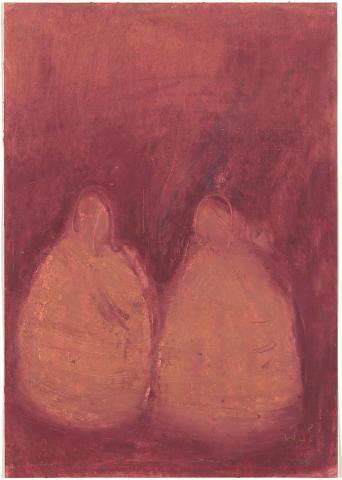ESSAY: SANPITAK, Pinaree; Untitled
Pinaree Sanpitak began gaining recognition in the Bangkok art world in the early 1990s and between 1991 and 1994, with artist Chatchai Puipia, she established Silom Art Space. She was one of six artists to initiate the important 'Womanifesto' exhibitions in 1997 and 1999, creating a dialogue between Thai and international female artists. Her work is concerned with issues of personal growth and experience. In the late 1990s she moved away from two-dimensional drawings and paintings to focus on increasingly abstracted and interactive sculptural forms.
In the male-dominated art world of Thailand, Sanpitak has revitalised traditional crafts and used the metaphor of the female body to address personal and universal themes of life, growth, death, ritual, nourishment and motherhood. Her art works engage with a tradition of Thai craft techniques and rural materials, and many are based on handmade Thai saa paper (made from mulberry fibre), or the form of the stupa or ritual vessel. Through these means Sanpitak's art engages with a Buddhist tradition of meditation and ritual, while also addressing the cultural legacy and unwritten history of indigenous craft forms, often produced by anonymous female artists.
In her work Sanpitak has used a variety of materials - from silk, saa paper, candle wax, acrylics and charcoal on paper or canvas, and cast bronze. Both the graphic and three-dimensional aspects of her practice have in common an attention to tactile materials and a sculptural quality. Although Sanpitak has used a number of bodily forms, the breast is a common motif in her work.
The two untitled drawings (Acc. nos 2005.308-309) relate to Sanpitak's mature work, and both take the breast as their point of departure. She has remarked: 'I have been using the "breast" form as a metaphor of the SELF for almost a decade since 1994. They have informed a continuous process in my art making.'(1) One drawing is red, with two breast or stupa-like forms while the other is black, with a single large breast-form dominating the composition. These sculptural drawings relate to Sanpitak's three-dimensional series 'Breast stupas' 2000-01, made by unthreading silk textiles, and to her 'Temporary insanity' series (2003-04), which consists of an immersive installation of soft-sculpture breast and stupa-like forms.
Sanpitak has said: 'Breasts ... I feel their presence. I admire their potential. Breasts are delicate, sensitive and unique. They are symbols of beauty. They are the baby's most important source of nutrition. They symbolise women as sex-objects. They are soft and warm. They have strength. They are victims. They have become taboo in some cultures.'(2)
Sanpitak's own experience of motherhood has influenced her commitment to exploring the feminine and feminist aspects of her artistic practice. Interested in the psychological and spiritual changes that women undergo as they mature, her work attempts to give visual shape to these ideas. Perhaps to avoid being typecast, Sanpitak rejects the label 'feminist', maintaining, 'I've always explored myself in art and I happen to be a woman'.(3) However, as art director and curator Apinan Poshyananda contends, her work 'redirects the viewer's attention away from the "male gaze" where women are often contextualized as possessions or sex objects.'(4)
Sanpitak's works subtly compel the viewer to examine their own preconceptions and participate in the artist's own experience, which she has described as follows: 'I wanted all my senses to blossom: to give rise to all possibilities, and consequently learn more about oneself.'(5)
1. Cemeti Art Foundation, Indonesia, , viewed 16 September 2005.
2. 'Breasts: Seen through a female painter's eye' [unidentified newspaper clipping], in Queensland Art Gallery Research Library artist files.
3. Sanpitak, Pinaree in 'On the breast behaviour', Caravan, undated, p.13.
4. Poshyananda, Apinan. 'Pinaree Sanpitak making her mark'. in Recent Works by Chatchai Puipia and Pinaree Sanpitak [exhibition catalogue], National Gallery, Bangkok, 1991, unpaginated.
5. Cemeti Art Foundation, 2005.
